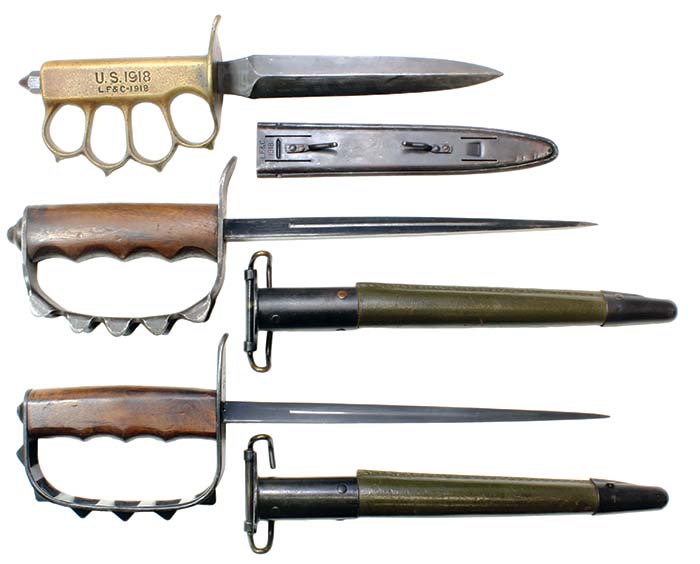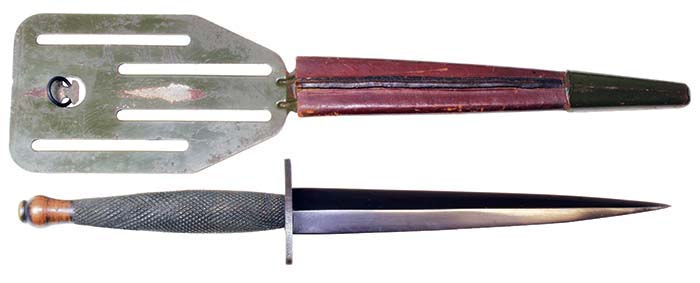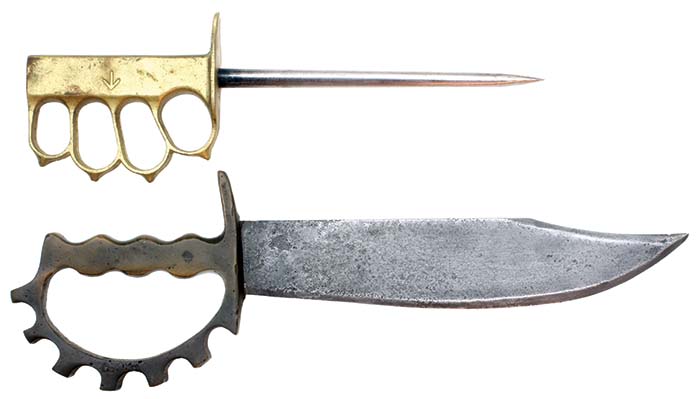The ubiquitous British Fairbairn-Sykes is a double-edged fighting knife developed by William Fairbairn and Eric Sykes while serving in China prior to World War II. With its 7-inch blade, the weapon is optimized for thrusting but is capable to inflict slashing cuts as well. Overall length is 11.5 inches. The F-S knife was used by British Commandos, airborne forces, the SAS and many other units, especially for the Normandy landing in June 1944. The style was copied and used by the OSS and Marine Raiders and other special forces, clandestine and raiding units.
By Robert G. Segel
Blades of some sort have been part of the soldier’s armament for centuries. From the earliest times of human history, it is the metal blade that enabled combatants to inflict serious or mortal wounds upon an enemy – up close and personal. Whether a spike on the tip of a lance, a short or long sword – either single or double edged, a dagger or stiletto, the battle blade it has many names and configurations.
Hand held bladed weapons tend to serve many uses for which therein lies a problem. The needle-like tip of a Fairbairn-Sykes fighting knife is an excellent piercing weapon but a broken tip is guaranteed if used to open a can of C-rations. A cavalry sword is designed for slashing and not for stealthy raiding parties. Like firearms, battle blades are designed for specific purposes and use. And while firearms allowed conflict to be done at a distance, there always is a need for a final personal defense weapon when certain situations arise.

Hand held battle blades are designed for stabbing, slicing or hacking and the size, shape and configuration of the blade pretty much determined their effectiveness. For instance, triangular blades were originally developed for stabbing and piercing through chainmail with the added benefit of producing a wound that was harder to stop or control the bleeding.
In the melee that is often the fight, a bladed weapon often had multiple usage options incorporated in the design to optimize the final results as manipulated by arm movements. This included a double edged blade to provide a slash cut whether swinging from right or left. The pommel often had a spike or cone shape to the end, called a “skull-crusher” to enable a backhanded injury after swinging through. Many battle blades also incorporated a brass, bronze or steel knuckle guard (aka brass knuckles) that often included spikes or flanges. While officially these “spiked brass knuckle” guards were to prevent an opponent from grabbing the knife-wielder’s hand, the more obvious devastating and terrifying brutal effect of being hit, particularly in the face, is self-evident.

Every army of every country around the world has some sort of combat blade – to this very day – usually in a more utilitarian purpose suitable for a number of purposes that include campsite activities, wire cutting and personal defense. The battle blades shown here are a sampling of some of the types used in World Wars I and II and are nowhere near a complete listing. And the number of commercially made hunting knives by well-known makers that soldiers carried on their own is not covered here. There are entire reference books on the subject whether by type, manufacturer, country or time period. But the battle blades shown here show the range of uses and applications in the first half of the 20th century.
Part II of Battle Blades will look at weapon mounted blades – bayonets – that were used in World War I and II.






Bottom: This World War II brass knuckle knife was made in Australia. Massive one-piece bronze knuckle handle and guard with steel Bowie-shaped blade. The blade is 9.5 inches long with an overall length of 14.25 inches. This knife was reported to be issued to U.S. Rangers and is thus known to collectors as the “Ranger Knuckle Knife,” but that is not the case as these knives were not officially issued to Rangers. These knives were produced and sold commercially in Australia and any number of allied soldiers could have purchased and used them – including Rangers – as they are formidable weapons.

| This article first appeared in Small Arms Review V19N8 (October 2015) |











